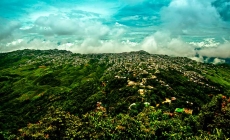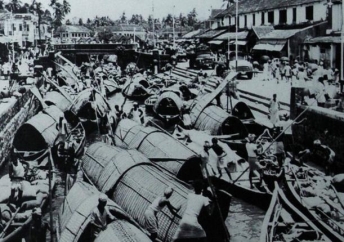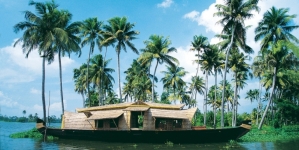-
Rajasthan - November 4, 2015
-
Haryana History - November 1, 2015
-
Haryana - November 1, 2015
-
Mizoram Minerals - March 3, 2015
-
Mizoram Hotels - March 2, 2015
-
Mizoram Culture - March 2, 2015
-
Mizoram Tourist Places - March 2, 2015
-
Mizoram History - March 1, 2015
-
Chhattisgarh Minerals - February 27, 2015
-
Chhattisgarh Hotels - February 27, 2015
Kerala History – Detailed Information About the History of Kerala
There is limited information available about the ancient period of Kerala history. This is because there is hardly any written record left from the time nor is there enough evidence to prove them. There are many myths and speculations about the creation of Kerala and its early periods. According to Hindu mythology, Kerala was created by Parasuram, one of the avathars (incarnation) of MahaVishnu. Geologists believe that Kerala was formed by some seismic activity, gradually or suddenly.
Based on the available details, the history of Kerala can be conveniently divided into various periods.
- Ancient Period
- Sangham Period
- Post-Sangham Period
- Kulashekara Period ( Quilon Year begins )
- Period of Provincial Rulers
- European Arrival
- British Rule
- Freedom struggle and Independence
History of Kerala – Ancient Period
Ancient Period refers to the time before the Christian era. As mentioned earlier, history of Kerala can be traced back to 4000 B.C., when Proto Australoid and Negrito race inhabited the land. Microlithic artifacts dating back to 4000 B.C. have been recovered from near Calicut. Megalithic monuments like various kinds of burial stones and urns and some man-made underground chambers have also been found. By around 3000 B.C., Kerala had trade relation with Sindhu Valley Civilization and its spices and commodities like Sandalwood, Ivory, Teakwood etc. were exported to many countries of the west. Kerala held a considerable position in the commercial map of the ancient world. It is believed that the Peacocks, Monkeys, Ivory and spices which King Solomon received, were imported from Kerala . It was by 700 B.C. that the Dravidians migrated to south India from the Mediterranean region. The Aryans entered Kerala from north India by 300 B.C.
270 B.C. to 240 B.C. saw the spread of Buddhism in Kerala. The oldest record about Kerala is found in one of the rock edict by emperor Asoka dating back to B.C. 257.
Sangham Period in Kerala History
This period can be dated from the beginning of the Christian era to the middle of the 7th century. ‘Sanghams’ were assemblies or groups of poets which were in existence in various parts of the Pandiyan Empire. The aim of these Sanghams was to encourage poetic arts. Three Sanghams are known to have existed during the period.
Heppalus, a Roman-Greek sailor reached Musiris (Kodungalloore) in A.D. 45 and this enabled direct trade with Roman empire. The distance of sea voyages were reduced by the discovery of new routes. Many mariners like Heppalus, Panthenus, Huan Tsang, Cosmos Indicopleustes etc., landed at the coasts of Kerala during this period.
By around 50 – 125 A.D., the Chera kings captured parts of northern Kerala. During this period also, Kerala had strong trade with the West. In A.D. 52, St. Thomas reached Kerala and Christianity began to flourish. With the demolition of Jerusalem church by the Romans, the Jews fled from Israel and some of them reached Kerala. As per the book Keralolpathy, the period up to 216 A.D. is known as ‘Parasurama period’ and the period 216 A.D. to 428 A.D. is known as age of ‘Perumals’. The Brahmin families which migrated to Kerala were settled to 64 villages. In 644 A.D., Malikben Dinar reached Kerala and he constructed Mosques and propagated Islam. Cheran Chenguttuvan (125-180) was one of the famous rulers of this era.
Post-Sangham Period in the History of Kerala
The period ranging from the middle of 7th century to the early part of the 9th century is known as the Post – Sangham period. This was the period when Buddhism began to decline. The main rulers of this period were Cheraman Perumal and Kulasekara Alwar. Both these kings later abdicated their thrones. Kulasekara Alwar later became a Vaishnavite poet and Cheraman Perumal accepted Islam and went to Mecca. Adi Shankara (Sankaracharya, 788 – 820 A.D.) lived and propagated the Advaida philosophy during this period. Each king during the period was enthroned for a period of 12 years. After his term, a new king was selected following a festival or cultural event known as ‘ Mamankam ‘. These type of events are unique to Kerala.
Kulasekara Periods – Kerala History
The next period in Kerala history is the period of rule of the Kulasekara Kings. Kulasekara empire lasted for about 3 centuries beginning from 800 AD. This period is also known as the Period of ‘Second Chera’ empire. These kings were known after their family name as Kulasekaras. Kolla Varsha or the Quilon Calendar (Malayalam Calendar system) was introduced during this period. It came into existence on the 25th of July , 825 A.D. Quilon city was reconstructed by Maruvan Sabareso. The Pandyas retreated from Kerala occupation.Sthanu Ravi Varma, Bhaskara Ravi I, Bhaskara Ravi II were main rulers of this period. Between 1000 and 1019, Raja Raja Chola and Rajendra Chola attacked Kerala. Rajendra Chola seized vizhinjam. In 1070 Kerala was liberated from Chola control.
Kerala History – Period of the Provincial rulers
Frequent wars with the Chola and Pandya kingdoms weakened the Chera empire and finally lead to their breakdown. With the breakdown of Chera empire the next phase of Kerala history began. This was the period of the provincial rulers. Provincial rulers were those who took control of a small province rather than a large empire. These provinces were once part of the Chera empire. The provincial rulers were confined to small areas but they frequently fought each other for domination. The kings of Venad and Kochi and Zamorins of Kozhikode were the prominent rulers.
European Arrival in Kerala
Arrival of the Europeans marked the beginning of another era in the history of Kerala. In 1498, Vasco da Gama reached Kappad, near Kozhikode. This was followed by the arrival of a number of Europeans. Though the main aim of their visit was trade and discovery of a shorter sea route to the Malabar coast, the prevailing political instability paved way for their entry into the administration. Making use of the rivalry between the provincial rulers, they started by providing military assistance to one ruler against the other. By and by, their influence increased to such an extend that they began running the administration with the rulers acting as puppets in their hands. Wars and skirmishes still continued between various native rulers and this provided the Europeans more and more opportunities to interfere into the administration. The Portuguese were the first Europeans to establish a stronghold in Kerala. This was later followed by the Dutch and the British. A number of battles were fought between the provincial rulers against each other and against the Portuguese. In 1524 Vasco da Gama was appointed the Portuguese Viceroy of Kerala. Kochi and Kozhikode were the main provinces of the time. Zamorins, the rulers of Kozhikode, fought a number of battles against the Portuguese.
Following the Portuguese, the Dutch reached Kerala. They began by the establishment of the Dutch East India Company in the year 1592. In 1604, the Dutch army arrived at the Malabar coast. They entered the arena of Kerala politics by making use of the rivalry between Kochi and Kozhikode. Their arrival marked the beginning of another phase of European domination. The Portuguese slowly began to loose control over to the Dutch. Dutch established their base at various parts of Kerala and made a number of treaties with local rulers. These treaties bestowed them with more powers. The Dutch supremacy lasted only for a short period before the British entry into Kerala. In 1725, the French established their base at Mahe. But unlike in the African continent, they were unable to make a move in on. Even while the Europeans emerged as great powers, war continued between the provinces. Marthanda Varma (1706 – 1761),the ruler of Travancore, was one of the strongest rulers of the time. With the arrival of the British begins another chapter of Kerala history.
British Rule in Kerala
Like any other Europeans, British also had great interest in Kerala. They too were attracted by the spices and other natural treasures of the land. British supremacy in Kerala started by the mid seventeenth century and lasted for the next 200 years until independence. Though a number of wars and revolts were made against them, the British were able to suppress them quickly. This was mainly because of the lack of unity among the provinces. Kochi and Travancore were the prominent kingdoms. The rule of the British saw many changes in the social and cultural life of Kerala. Slavery was slowly abolished. English missionaries played an important role in improving the living standard of the people. During this period a number of educational institutions and hospitals were opened. Many railway lines , roads and bridges were constructed by the British. In a way, Kerala is indebted to the British for its modernization.
This period also saw the emergence of a number of social reformation movements. Many reformers like Chattambi Swamikal, Sree Narayana Guru and Ayyankali played a vital role in the upliftment of the downtrodden and the emancipation of the women folks.
Freedom Struggle and Independence
Though there were a number uprisings against the foreign rule right from the beginning, its intensity and frequency increased by the early 1900’s. The early revolts and battles against the rule like the Pazhassi and Mappilai revolts were suppressed with iron fist by the British. The World Wars weakened the colonial powers and this gave a boost to the nationalist movements in the colonies. In India, nationalist movements gained momentum under the strong leadership of Mahatma Gandhi. These movements had their effect on Kerala as well. Kerala division of Indian National Congress was launched. The Khilafat Movement, organized under the leadership of Indian National Congress had a huge influence over the muslim community of the Malabar region. Following the Khilafat Movement was the Malabar mutiny (1921). The movement lasted for quite some time before it was suppressed. The lower castes were denied permission to use the temple roads. Against this, in 1924 started the Vaikom Satyagraha. This was totally a social movement. This movement was successfully ended by the intervention of Mahatma Gandhi in 1925. In 1930, British levied tax on salt and they imposed restrictions on production of salt. This aroused nation wide agitation. In Kerala, under the leadership of K. Kelappan, this law was defied and salt was produced. A number of big and small movements arouse until 1947, when finally the land was free from the clutches of colonialism.
On July 1, 1949, the princely states of Travancore and Cochin were integrated to form Travancore – Cochin (Thiru-Cochi) state. But it was on November 1, 1956, that Kerala as a state came into existence. This was by the consolidation of Malabar province, which was a part of the Madras Presidency and the Travancore – Cochin state.
Reference:
http://www.prokerala.com/kerala/history/



















